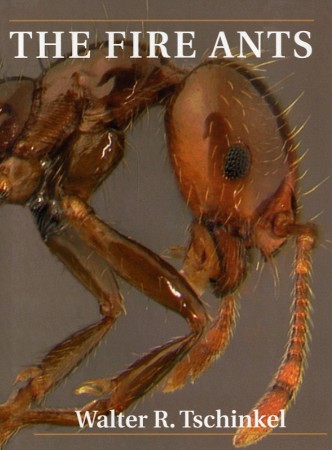The fire ants

| Auteurs |
|
| Éditeurs |
|
| Parution | 01/01/2006 |
| Pages | 752 |
| Catégorie |
|
| Langue |
|
Présentation
Walter Tschinkel's passion for fire ants has been stoked by over thirty years of exploring the rhythm and drama of Solenopsis invicta's biology. Since South American fire ants arrived in Mobile, Alabama, in the 1940s, they have spread to become one of the most reviled pests in the Sunbelt.
In Fire Ants Tschinkel provides not just an encyclopedic overview of S. invicta--how they found colonies, construct and defend their nests, forage and distribute food, struggle among themselves for primacy, and even relocate entire colonies--but a lively account of how research is done, how science establishes facts, and the pleasures and problems of a scientific career.
Between chapters detailed enough for experts but readily accessible to any educated reader, "interludes" provide vivid verbal images of the world of fire ants and the people who study them. Early chapters describe the several failed, and heavily politically influenced, eradication campaigns, and later ones the remarkable spread of S. invicta's "polygyne" form, in which nests harbor multiple queens and colonies reproduce by "budding." The reader learns much about ants, the practice of science, and humans' role in the fire ant's North American success.
Sommaire
- Foreword by Edward O. Wilson vii
- 1I. Origin and Spread, Present and Future Range
- 3Prelude: And What Do You Do for a Living?
- 51. A Quick Tour of Fire Ant Biology
- 132. The Species of Fire Ants and Their Biogeography
- 223. An Atlas of Fire Ant Anatomy
- 234. Getting There
- 375. La Conquista: Spreading Out
- 75Interlude: Another Immigrant Moves West
- 836. Predicting Future Range Limits
- 93II. Basic Needs and the Monogyne Colony Cycle
- 95An Important Note: Monogyne and Polygyne Social Forms
- 967. Shelter
- 103Interlude: There's Nothing Like Getting Plastered
- 1068. Space
- 1219. Food
- 130Interlude: Mundane Methods
- 13610. Mating and Colony Founding
- 147Interlude: Spring among the Fire Ants
- 15011. The Claustral Period
- 165Interlude: Sharon's House of Beauty
- 16812. The Incipient Phase and Brood Raiding
- 18613. Dependent Colony Founding
- 19314. Colony Growth
- 20515. Relative Growth and Sociogenesis
- 227Interlude: The Porter Wedge Micrometer
- 22916. Colony Reproduction and the Seasonal Cycle
- 247III. Family Life
- 249Interlude: Deby Discovers Ants
- 25117. Nestmate and Brood Recognition
- 269Interlude: Ant ID Systems
- 27218. Division of Labor
- 292Interlude: Moving Up in a Harvester Ant Colony
- 29519. Adaptive Demography
- 309Interlude: Driving to Work with Odontornachus
- 30820. The Organization of Foraging
- 328Interlude:Who's in Charge Here?
- 33021. Food Sharing within the Colony
- 358Interlude. The Fire Ant on Trial
- 36422. Venom and Its Uses
- 384Interlude: You Call That Pain!?
- 38623. Social Control of the Queen's Egg-laying Rate
- 396Interlude: Catching Queens
- 39824. Necrophoric Behavior
- 403IV Polygyny
- 40525. Discovery of Polygyny
- 412Interlude: I Want This to Re Accurate
- 41526. The Suppression of Independent Colony Founding in Polygyne Colonies
- 44227. The Nature and Fate of Polygyne Alates
- 454Interlude: A Useful Tool
- 45628. Polydyne Mating, Adoption, Execution
- 49529. Biological Consequences of Polygyny
- 501V. Populations and Ecology
- 50330. Hybridization between Solenopsis invicta and S. richteri
- 51231. Populations of Monogyne Fire Ants
- 541Interlude: Gang Wars
- 54432. Territorial Behavior and Monogyne Population Regulation
- 55033. Ecological Niche
- 56834. Solenopsis invicta and Ant Community Ecology
- 595Interlude: Membership in a Prestigious Organization
- 59735. Solenopsis invicta and Other Communities
- 61236. Fire Ants and Vertebrates
- 628Interlude: A Microsafari in Antland
- 62937. Biological Control
- 667Interlude: The Heartbreak of Parasitoids
- 671Some Final Words
- 673References
- 707Acknowledgments
- 709Index
- 280Color plates follow page
- 17 lectures
Bibliothèque
